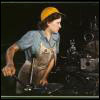Session Overview

|
As we’ve already learned, consumers gain utility from buying goods—but every good has to come from somewhere! Goods are produced by firms, and analyzing the decisions of firms is also central to our understanding of the economy. In this lecture, we will learn how companies make important operation decisions. When considering firm production decisions, we must consider the two forms of firm input – labor and capital. This image is a work of the US Federal Government and in the public domain. Source: Library of Congress. |
Keywords: Production theory; firm production functions; variable inputs; fixed inputs; short run production; long run production; marginal rate of technical substitution; returns to scale.
Session Activities
Readings
Read the recitation notes, which cover new content that adds to and supplements the material covered in lecture.
Before watching the lecture video, read the course textbook for an introduction to the material covered in this session:
Lecture Videos
Resources
Check Yourself
Concept Quiz
This concept quiz covers key vocabulary terms and also tests your intuitive understanding of the material covered in this session. Complete this quiz before moving on to the next session to make sure you understand the concepts required to solve the mathematical and graphical problems that are the basis of this course.
Question 1
What is the primary objective of firms?
Costs and revenue are relevant to the firm's decision, but their primary objective is maximizing profit. Utility is maximized by consumers, not firms.
Question 2
What is the difference between the short-run and the long-run from the perspective of production theory?
In the short run, it is easy for a firm to adjust how many employees it has, but it cannot immediately build a new factory or install new equipment. In the long-run, both labor and capital can be changed.
Question 3
Which of the following is NOT a property of isoquants?
Isoquants can be linear when inputs are perfectly substitutable, and thus it is not the case that they are always non-linear.
Question 4
What is the term used to describe a production function in which you can double all inputs and output increases by more than double?








